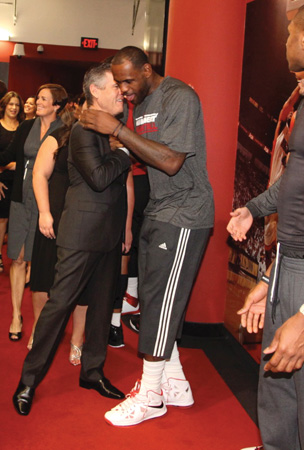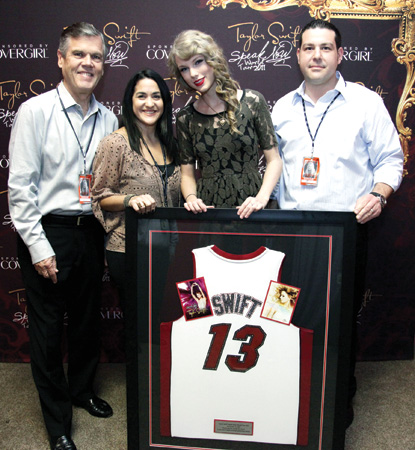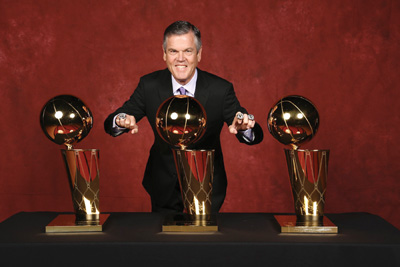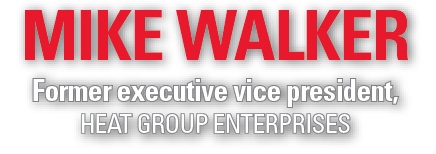Mike Walker retired last June as executive vice president of Heat Group Enterprises, which handles the marketing and booking business for AmericanAirlines Arena. Walker spent 13 years with the Heat as part of his distinguished 45-year career and was instrumental in establishing the facility as one of the leading venues in the country.
Before his job at the Heat, Walker worked as a vice president for Delaware North and as a senior executive for Madison Square Garden and Radio City Music Hall. Walker, 71, a Southern California native, began his career with Disney in 1969. He recently spoke with SportsBusiness Journal staff writer John Lombardo.
ALL PHOTOS COURTESY OF MIAMI HEAT
■ I got started with the Disney organization. I grew up in Southern California, went to Chapman University in Orange County and started working at Disney as a ride operator while I was in school. It was steam trains and most of the time after that on the monorail. I went into the service and then took a full-time job in the marketing department at Disneyland in 1969.
■ Disney is so embedded in so many businesses today. It was the philosophy from day one that the guests were the most important focus of their business and they tried to create an environment to put everyday life behind when you entered the Magic Kingdom. The focus was on putting on a great show. I carried that with me throughout my career whatever the venue might be. Today it still works, and I never lost sight of that.
■ I got recruited by Radio City Music Hall in 1981 by a Disney guy who had been hired to bring back Radio City Music Hall. I was the marketing guy at the time. We turned the place around. We had everything from the Grateful Dead, which was a real right turn, to the Christmas show, which is still the golden goose, and a combination of everything in between.
■ The trends today are heavily weighted on the technology side of the business. It is such a fast-changing business that you want to make sure you are on the cutting edge. In AmericanAirlines Arena, we tried to be focused in that business for a long time. Everything from social media to mobile apps, we needed to market it to the consumer, whether they were 12 or 75. It is the new age of marketing. It is how people enter the building, order their concessions or purchase their tickets.
 |
Walker with James: “We got LeBron in 2010 and it really focused the arena.”
|
■ The challenging thing is to stay up with it. I say it with some concern. The personal element should never be lost. The fans should feel like guests and the employees should feel like they are part of a family working for an organization.
■ When I got to AmericanAirlines Arena, it had been open for a year and not doing as well as management had expected. The challenge in Miami was that we had two arenas built within a couple of years with AmericanAirlines Arena and the then-Sunrise Arena near Fort Lauderdale. It became very competitive. The competition was focused initially in mainstream music.
■ We were getting our hats handed to us when the other building was making more inroads. It became obvious. The Latino business, which is very big in South Florida, was staying in the old Miami Arena. One of the first things I did was to reach out to Latin promoters. We started to develop a strong base of Latin music, which led us to talking to other promoters.
■ The real turnaround was when we secured the MTV Video Music Awards in 2004. It was the 20th anniversary of the show and that put us on the map for all genres.
■ Then there was the Shaq impact in 2004 [when Shaquille O’Neal was traded to the Heat] and it put us in the headlines. Then we got LeBron [James] in 2010 and it really focused the arena. All of a sudden, there was no sitting back. He had a definite impact. What we did in Miami was beyond the confines of the arena. Not only were we aggressive in the event business, but basketball was at the top of the charts. Now all of a sudden we were the arena of choice not just for sports but for events as well.

■ There is no border to where arena technology can go. It really will be something that will engage fans in the experience from the time you buy a ticket to when you arrive at the arena. Operators will know who you are, what you are buying, and the promotion of the brand will be 24/7. I remember how we used to promote the team or concert with a full-page ad and some radio. Teams don’t do that anymore. It is a whole different way of communication with your fan base.
 |
Walker welcomed Taylor Swift to AmericanAirlines Arena in 2011 with help from the arena’s Liz Roca and Jarred Diamond.
|
■ I am now 71 years old, but I feel like I’m 51. It has to do with the great career I had. It was a fun time. I’d like to do things on a project-by-project basis.
■ Over the years, the business has consolidated. Obviously, you have the 800-pound gorilla in Live Nation, then AEG, and everyone follows after that. Basically the day of the local or regional promoter doesn’t exist anymore. You deal with Los Angeles and New York. The business today is much more focused.
■ Promoters look at buildings in how they can route their artists and whether they can guarantee their artists. They have to pick the right cities and route the right way. The challenge is to find new acts that can fill 12,000- to 15,000-seat arenas.
■ When I went to Madison Square Garden in 1987 as senior vice president of marketing, we did some fun things. We did the first preview center of new suites. We built a separate suite and walked clients into the environment to duplicate the experience. Now everyone has a preview center. We spent $200 million to renovate the building and they just spent $1 billion. It has changed in the cost of doing business.








